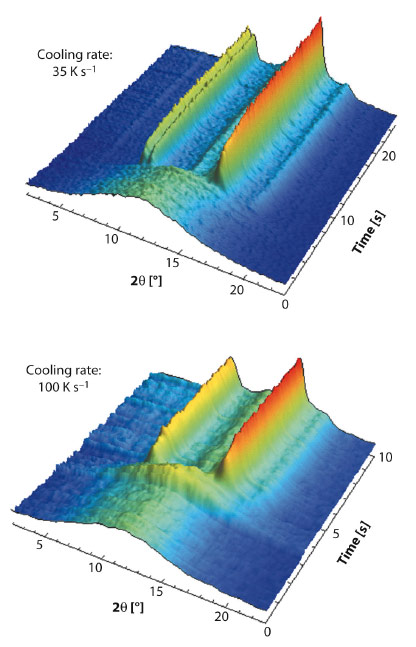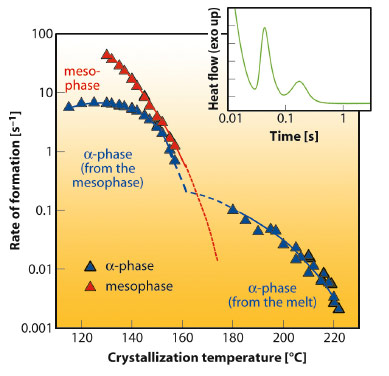- Home
- Users & Science
- Scientific Documentation
- ESRF Highlights
- ESRF Highlights 2012
- Soft condensed matter
- Dual crystallisation pathway in a semi-crystalline aromatic polyester
Dual crystallisation pathway in a semi-crystalline aromatic polyester
The understanding of the melt-crystallisation process in synthetic polymers represents a fundamental challenge, both from the scientific and technological points of view. Indeed, most of the polymers used in everyday products, from the fibres of our clothes to the shopping bags at the supermarkets, are crystallisable. However, the solidification conditions commonly applied during the production of plastic goods are largely different from those typically achieved in a laboratory. For instance, the cooling rates attained in actual processing span from few to hundreds K s-1, while they seldom reach 1 K s-1 in “classical” polymer crystallisation studies. Recently developed experimental techniques, such as nano-calorimetry or ultra-fast X-ray diffraction are now allowing us to fill this gap [1].
Even under isothermal or mild cooling conditions, polymer crystallisation suffers from kinetics limitations: the highly entangled melt of macromolecular chains is unable to form a completely ordered structure. As a result, crystallites always coexist with disordered amorphous regions, i.e., the material is semi-crystalline. Moreover, crystallisation at large undercoolings/high cooling rates might bring further complications, since structures with an intermediate degree of order between that of the amorphous phase and crystal, generally named “mesophases”, can develop [1,2].
The exact role of mesophases in polymer melt-crystallisation is debated. In many cases they can appear as intermediate states on the route to the ultimately stable crystalline structure, according to the well-known Ostwald’s rule of stages [3,4]. The controversy lies in the interpretation of these observations: whether the multi-stage process via metastable states is a general prerequisite of polymer crystallisation [3], or whether it is the manifestation of a kinetic effect such as mesophase formation being faster than crystal development [4].
In this work we have shown that the same semi-crystalline material can either “obey” or “defy” Ostwald’s rule of stages, depending on the crystallisation conditions. The material elected for the investigation is PBN, poly(butylene-2,6-naphthalate), an aromatic polyester with important applications as a high performance fibre. By coupling a custom-built quenching device with a state-of-the-art X-ray detector (Pilatus 300K-W) at beamline BM26 (DUBBLE-Dutch Belgian Beamline) [1], the crystallisation process can be monitored at industrially relevant cooling rates, up to about 200 K s-1.
Representative examples of time-resolved WAXD experiments during cooling from the melt are presented in Figure 90. A dual crystallisation behaviour can be appreciated. For the lowest cooling rate, the triclinic crystalline structure (α-phase) develops directly from the isotropic melt. In contrast, when the cooling rate is high enough, crystallisation of the α-phase is preceded by mesophase formation. This step can be recognised by a distinct enhancement of the scattering in the central region of the WAXD pattern with respect to the melt, indicating an increased lateral correlation of molecular segments.
 |
|
Fig. 90: Time-resolved WAXD patterns during cooling PBN samples at the indicated cooling rates. |
PBN offers the interesting possibility of probing the formation of crystals both from the melt and the pre-ordered mesomorphic phase. This can conveniently be done with conventional and chip-based differential scanning calorimetry. As shown in Figure 91 (inset), the formation of mesophase and its transformation to crystals at large undercooling are both detected as separated exothermic events in the calorimetric trace. The rates of the three transitions, namely melt to crystal, melt to mesophase and mesophase to crystal, can be compared in Figure 91.
 |
|
Fig. 91: Rate of mesophase and crystal formation as a function of temperature and example of calorimetric signal (inset). |
In conclusion, combining the results of fast scanning chip-calorimetry with time-resolved X-ray diffraction experiments, the reason behind the dual ordering behaviour of PBN can be unravelled. Crystallisation occurs directly from the melt at low undercooling, above the limit of stability of the mesophase or when its rate of formation is too sluggish. On increasing undercooling/cooling rate, mesophase formation from the melt becomes kinetically favoured in comparison to the melt-crystallisation process. In the latter case the material behaves accordingly to Ostwald’s rule of stages, exhibiting a two-step crystallisation mechanism.
Principal publication and authors
D. Cavallo (a), D. Mileva (b), G. Portale (c), L. Zhang (d), L. Balzano (a), G.C. Alfonso (d) and R. Androsch (b), ACS Macro Lett. 1, 1051-1055 (2012).
(a) Polymer Technology Group, Eindhoven University of Technology (The Netherlands)
(b) Center of Engineering Sciences, Martin-Luther University Halle-Wittenberg, Halle/Saale (Germany)
(c) DUBBLE CRG, ESRF, Grenoble (France)
(d) Department of Chemistry and Industrial Chemistry, University of Genova (Italy)
References
[1] D. Cavallo, G. Portale, L. Balzano, F. Azzurri, W. Bras, G.W. Peters and G.C. Alfonso, Macromolecules 43, 10208-10212 (2010).
[2] F. Auriemma, C. De Rosa and P. Corradini Adv. Polym. Sci. 181, 1-74 (2005).
[3] G.Strobl, Rev. Mod. Phys. 81, 1287-1300 (2009).
[4] S.Z.D. Cheng, Phase transitions in polymers: the role of metastable states Elsevier, Amsterdam (2008).



